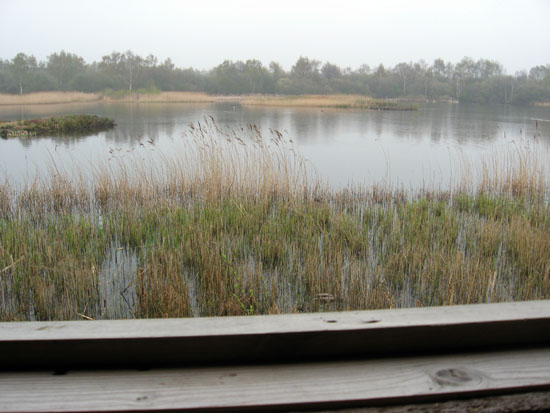| This article is incomplete. This article is missing one or more sections. You can help the BirdForum Opus by expanding it. |
Overview
This reserve of diverse habitat is owned by the Yorkshire Wildlife Trust. The main area of the reserve is of fen and bog, with several small areas of woodland ranging from dry Silver Birch Betula pendula wood to wetter carr woodland. A new area of the reserve has been developed as a marsh / open water area. The reserve has been accorded SSSI (Site of Special Scientific Interest) status for it's reed fen ecosystem.1
Birds
Notable Species
The reserve is much the best place in the county to see overwintering Great Bittern, with up to 6 birds having wintered in the last few years. Lesser Spotted Woodpecker are also being seen on a regular basis.
Rarities
Check-list
Birds you can see here include:
Little Grebe, Great Crested Grebe, Great Cormorant, Great Bittern, Grey Heron, Mute Swan, Greylag Goose, Canada Goose, Shelduck, Wigeon, Gadwall, Eurasian Teal, Mallard, Pintail, Northern Shoveler, Pochard, Tufted Duck, Goldeneye, Ruddy Duck, Sparrowhawk, Common Buzzard, Common Kestrel, Peregrine Falcon, Red-legged Partridge, Common Pheasant, Water Rail, Moorhen, Common Coot, Northern Lapwing, Common Ringed Plover, Common Snipe, European Curlew, Common Redshank, Spotted Redshank, Dunlin, Little Stint, Black-headed Gull, Common Gull, Lesser Black-backed Gull, Great Black-backed Gull, Common Tern, Stock Dove, Common Wood Pigeon, Eurasian Collared Dove, Common Cuckoo, Common Swift, Common Kingfisher, Green Woodpecker, Great Spotted Woodpecker, Lesser Spotted Woodpecker, Eurasian Skylark, Sand Martin, Barn Swallow, Western House Martin, Meadow Pipit, Yellow Wagtail, Grey Wagtail, Pied Wagtail, Eurasian Wren, Dunnock, Robin, Eurasian Blackbird, Song Thrush, Mistle Thrush, Sedge Warbler, Common Reed Warbler, Lesser Whitethroat, Common Whitethroat, Garden Warbler, Blackcap, Common Chiffchaff, Willow Warbler, Goldcrest, Long-tailed Tit, Willow Tit, Coal Tit, Blue Tit, Great Tit, Eurasian Treecreeper, Jay, Eurasian Magpie, Eurasian Jackdaw, Rook, Carrion Crow, Common Starling, House Sparrow, Eurasian Tree Sparrow, Chaffinch, European Greenfinch, European Goldfinch, Eurasian Siskin, Eurasian Linnet, Lesser Redpoll, Eurasian Bullfinch, Yellowhammer, Reed Bunting
Other Wildlife
Among the mammals recorded on the reserve are European Rabbit Oryctolagus cuniculus, Brown Hare Lepus europaeus, Red Fox Vulpes vulpes, European Badger Meles meles, Grey Squirrel Sciurus carolinensis, European Roe Deer Capreolus capreolus, Water Vole Arvicola terrestris, Harvest Mouse Mycromis minutus. The Reserve has an excellent invertebrate population. 26 species of butterfly and 20 species of dragonfly/damselfly have been recorded. There is also an extensive moth list of over 600 species. Other invertebrate goups include a number of Red Data Book species and "Notable" Nb species. There is also an extensive botanical list. The list of fungi is extensive including the rarity Allopsalliota geesteranii which was discovered for the first time in England at Potteric Carr in 2004.
Site Information
History and Use
The reserve and its surrounding area have always been low lying land, mainly fen and bog until it was drained during the mid 18th century in order to acquire the land for agriculture. With the Industrial Revolution during the 19th century the area became criss-crossed by numerous railway lines and was virtually impossible to farm. Following mining subsidence under the area in the middle of the last century, a large part of the reserve reverted back to fen and bog. In 1968 the Yorkshire Wildlife Trust acquired some of the land as a nature reserve, and following additions during the 1970's the reserve reached it's current size of 200ha.1 There are still active railway lines crossing the reserve area so some of the reserve is inaccessible to the general public.
Areas of Interest
The Piper Marsh hide is probably the most popular area of the reserve during the winter months as this hide is the most consistent provider of views of the wintering Great Bittern. Willow Pool hide overlooks a feeding station and it is not unusual to see Water Rail coming out into the open to take food from the ground beneath the feeding table.
Access and Facilities
The reserve can be reached from the M18 motorway, leaving at Junction 3 and taking the road towards Doncaster. At the first roundabout take the 3rd exit and within 100 metres you will reach the car park for the reserve on the right, an overflow car park is on the left. Entry to the reserve is through Sedum House, HQ for the British Trust for Conservation Volunteers.
Permits are required to access the area, fee payable, and you are not allowed to cross the railway tracks without a permit.
There are roughly 8 km of paths and 14 hides, with some 5km of paths wheelchair friendly and all but 2 of the hides suitable for disabled access.
The Field Centre cafe is open 7 days per week for food and drinks, 10.00am to 4.00pm.
Grid Ref. SE 599003.
Contact Details
Potteric Carr Nature Reserve 01302 570077
References
External Links
Content and images originally posted by Keith Dickinson, 7 December 2008




